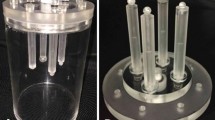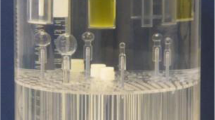Abstract
Since the early 2000s, many types of positron emission tomography (PET) scanners dedicated to breast imaging for the diagnosis of breast cancer have been introduced. However, conventional performance evaluation methods developed for whole-body PET scanners cannot be used for such devices. In this study, we developed phantom tools for evaluating the quantitative accuracy of positron emission mammography (PEM) and dedicated-breast PET (dbPET) scanners using novel traceable point-like 68Ge/68 Ga sources. The PEM phantom consisted of an acrylic cube (100 × 100 × 40 mm) and three point-like sources. The dbPET phantom comprised an acrylic cylinder (ø100 × 100 mm) and five point-like sources. These phantoms were used for evaluating the fundamental responses of clinical PEM and dbPET scanners to point-like inputs in a medium. The results showed that reasonable recovery values were obtained based on region-of-interest analyses of the reconstructed images. The developed phantoms using traceable 68Ge/68 Ga point-like sources were useful for evaluating the physical characteristics of PEM and dbPET scanners. Thus, they offer a practical, reliable, and universal measurement scheme for evaluating various types of PET scanners using common sets of sealed sources.






Similar content being viewed by others
References
Hsu DF, Freese DL, Levin CS. Breast-dedicated radionuclide imaging systems. J Nucl Med. 2016;57(Supp 1):40S-45S.
Berg WA, Weinberg IN, Narayanan D, Lobrano ME, Ross E, Amodei L, Tafra L, Adler LP, Uddo J, Stein W 3rd, Levine EA. Positron emission mammography working group. High-resolution fluorodeoxyglucose positron emission tomography with compression (“positron emission mammography”) is highly accurate in depicting primary breast cancer. Breast J. 2006;12:309–23.
Schilling K, Conti P, Adler L, Tafra L. The role of positron emission mammography in breast cancer imaging and management. Appl Radiol. 2008;37:26–36.
Berg WA, Madsen KS, Schilling K, Tartar M, Pisano ED, Larsen LH, Narayanan D, Ozonoff A, Miller JP, Kalinyak JE. Breast cancer: comparative effectiveness of positron emission mammography and MR imaging in presurgical planning for the ipsilateral breast. Radiology. 2011;258:59–72.
Schilling K, Narayanan D, Kalinyak JE, The J, Velasquez MV, Kahn S, Saady M, Mahal R, Chrystal L. Positron emission mammography in breast cancer presurgical planning comparisons with magnetic resonance imaging. Eur J Nucl Med Mol Imaging. 2011;38:23–36.
Iima M, Nakamoto Y, Kanao S, Sugie T, Ueno T, Kawada M, Mikami Y, Toi M, Togashi K. Clinical performance of 2 dedicated PET scanners for breast imaging: Initial evaluation. J Nucl Med. 2012;53:1534–42.
Yamamoto Y, Tasaki Y, Kuwada Y, Ozawa Y, Inoue T. A preliminary report of breast cancer screening by positron emission mammography. Ann Nucl Med. 2016;30:130–7.
Nishimatsu K, Nakamoto Y, Miyake KK, Ishimori T, Kanao S, Toi M, Togashi K. Higher breast cancer conspicuity on dbPET compared to WB-PET/CT. Eur J Radiol. 2017;90:138–45.
National Electrical Manufacturers Association (NEMA). Performance measurements of positron emission tomographs. NEMA Standards Publication. NU2–1994 pp. 1–28
National Electrical Manufacturers Association (NEMA). Performance measurements of positron emission tomographs NEMA. Standards Publication. NU2–2019 pp. 1–41
International Electrotechnical Commission (IEC). Radionuclide imaging devices - Characteristics and test conditions - Part 1: Positron emission tomographs. IEC Standard. 1998;61675–1 pp. 1–35
International Electrotechnical Commission (IEC). Radionuclide imaging devices - Characteristics and test conditions - Part 1: Positron emission tomographs. IEC International Standard. 2013;61675–1 pp. 1–38
Springer A, Mawlawi OR. Evaluation of the quantitative accuracy of a commercially available positron emission mammography scanner. Med Phys. 2011;38:2132–9.
Wu Y, Bowen SL, Yang K, Packard N, Fu L, Burkett G, Qi J, Boone JM, Cherry SR, Badawi RD. PET characteristics of a dedicated breast PET/CT scanner prototype. Phys Med Biol. 2009;54:4273–87.
Moliner L, Gonzalez AJ, Soriano A, Sanchez F, Correcher C, Orero A, Carles M, Vidal LF, Barbera J, Caballero L, Seimetz M, Vazquez C, Benlloch JM. Design and evaluation of the MAMMI dedicated breast PET. Med Phys. 2012;39:5393–404.
García Hernández T, Vicedo González A, Ferrer Rebolleda J, Sánchez Jurado R, Roselló Ferrando J, Brualla González L, Granero Cabañero D, Santiago DPC, M,. Performance evaluation of a high resolution dedicated breast PET scanner. Med Phys. 2016;43:2261–72.
Satoh Y, Motosugi U, Imai M, Onishi H. Comparison of dedicated breast positron emission tomography and whole-body positron emission tomography/computed tomography images: A common phantom study. Ann Nucl Med. 2020;34:119–27.
National Electrical Manufacturers Association (NEMA). Performance measurements of small animal positron emission tomographs. NEMA Standards Publication. NU4–2008 pp. 1–23
Luo W, Anashkin E, Matthews CG. Performance evaluation of a PEM scanner using the NEMA NU4-2008 small animal PET standards. IEEE Trans Nucl Sci. 2010;57:94–103.
Miyake KK, Matsumoto K, Inoue M, Nakamoto Y, Kanao S, Oishi T, Kawase S, Kitamura K, Yamakawa Y, Akazawa A, Kobayashi T, Ohi J, Togashi K. Performance evaluation of a new dedicated breast PET scanner using NEMA NU4-2008 Standards. J Nucl Med. 2014;55:1198–203.
Japan Medical Imaging and Radiological Systems Industries Association (JIRA). Performance evaluation of positron emission tomographs. JESRA X-0073*G-2019
Raylman RR, Majewski S, Smith MF, Proffitt J, Hammond W, Srinivasan A, McKisson J, Popov V, Weisenberger A, Judy CO, Kross B, Ramasubramanian S, Banta LE, Kinahan PE, Champley K. The positron emission mammography/tomography breast imaging and biopsy system (PEM/PET): Design, construction and phantom-based measurements. Phys Med Biol. 2008;53:637–53.
Spinks T, Jones T, Heather J, Gilardi M. Quality control procedures in positron tomography. Eur J Nucl Med. 1989;15:736–40.
Geworski L, Knoop BO, de Wit M, Ivancević V, Bares R, Munz DL. Multicenter comparison of calibration and cross calibration of PET scanners. J Nucl Med. 2002;43:635–9.
Boellaard R. Standards for PET image acquisition and quantitative data analysis. J Nucl Med. 2009;50:11S-20S.
Zimmerman BE, Cessna JT. Development of a traceable calibration methodology for solid 68Ge/68Ga sources used as a calibration surrogate for 18F in radionuclide activity calibrators. J Nucl Med. 2010;51:448–53.
Zimmerman BE, Pibida L, King LE, Bergeron DE, Cessna JT, Mille MM. Development of a calibration methodology for large-volume, solid 68Ge phantoms for traceable measurements in positron emission tomography. Appl Radiat Isot. 2014;87:5–9.
Zimmerman BE, Bergeron DE, Cessna JT. Impact of recent change in the National Institute of Standards and Technology standard for 18F on the relative response of 68Ge-based mock syringe dose calibrator standards. J Nucl Med. 2015;56:1453–7.
Hasegawa T, Sato Y, Oda K, Wada Y, Murayama H, Yamada T. Semi-quantitative and simulation analyses of effects of γ rays on determination of calibration factors of PET scanners with point-like 22Na sources. Phys Med Biol. 2011;56:6031–45.
Hasegawa T, Okamoto M, Yamada T, Ishizu H, Mikamoto T, Sato Y, Miyatake H, Kikuchi K, Inoue Y. Traceable point-like 68Ge/68Ga source with a spherically symmetric positron absorber for PET scanners. Radiol Phys Technol. 2020;13:170–6.
Yamada Y, Kitamura K, Hashizume N, Yamakawa Y, Kumaza Y. Reconstruction of 4-Layer DOI detector equipped C-Shaped PEM via list-mode iterative algorithm. IEEE Nuclear Science Symposium Conference Record. 2007;4397–4400. https://doi.org/10.1109/NSSMIC.2007.4437087
Hasegawa T, Oda K, Wada Y, Sasaki T, Sato Y, Yamada T, Matsumoto M, Murayama H, Kikuchi K, Miyatake H, Abe Y, Miwa K, Akimoto K, Wagatsuma K. Validation of novel calibration scheme with traceable point-like 22Na sources on six types of PET scanner. Ann Nucl Med. 2013;27:346–54.
Panetta JV, Daube-Witherspoon ME, Karp JS. Validation of phantom-based harmonization for patient harmonization. Med Phys. 2017;44:3534–44.
van der Vos CS, Koopman D, Rijnsdorp S, Arends AJ, Boellaard R, van Dalen JA, Lubberink M, Willemsen ATM, Visser EP. Quantification, improvement, and harmonization of small lesion detection with state-of-the-art PET. Eur J Nucl Med Mol Imaging. 2017;44(Suppl 1):4–16.
Namías M, Bradshaw T, Menezes VO, Machado MAD, Jeraj R. A novel approach for quantitative harmonization in PET. Phys Med Biol. 2018;63: 095019.
Disselhorst JA, Brom M, Laverman P, Slump CoH, Boerman OC, Oyen WJG, Gotthardt M, Visser EP. Image-quality assessment for several positron emitters using the NEMA NU 4–2008 standards in the Siemens Inveon small-animal PET scanner. J Nucl Med. 2010;51:610–7.
Jakoby BW, Bercier Y, Conti M, Casey ME, Bendriem B, Townsend DW. Physical and clinical performance of the mCT time-of-flight PET/CT scanner. Phys Med Biol. 2011;56:2375–89.
MacDonald L, Edwards J, Lewellen T, Haseley D, Rogers J, Kinahan P. Clinical imaging characteristics of the positron emission mammography camera: PEM Flex Solo II. J Nucl Med. 2009;50:1666–75.
Acknowledgements
We would like to thank Takahiro Yamada (Kinki University), Yasushi Sato (AIST), Mikio Matsuo, Hidetaka Ishizu, and Takahiro Mikamoto (JRIA) for their collaboration in the development and production of the traceable 68Ge/68Ga point-like sources. We would also like to thank Kentaro Takahashi (Kitasato University Graduate School) for help with related data analyses. Finally, we would like to thank Kenta Miwa (Fukushima Medical University), and Noriaki Miyaji (Cancer Institute Hospital of JFCR) for their collaboration with the multicenter studies using traceable point-like sources. This study was supported in part by JSPS KAKENHI JP18K07688 and JP21K07605.
Author information
Authors and Affiliations
Corresponding author
Ethics declarations
Conflict of interest
The authors have no conflict of interest. This article does not contain any studies performed with human and animals.
Additional information
Publisher's Note
Springer Nature remains neutral with regard to jurisdictional claims in published maps and institutional affiliations.
About this article
Cite this article
Okamoto, M., Hasegawa, T., Oda, K. et al. Dedicated phantom tools using traceable 68Ge/68Ga point-like sources for dedicated-breast PET and positron emission mammography scanners. Radiol Phys Technol 16, 49–56 (2023). https://doi.org/10.1007/s12194-022-00692-0
Received:
Revised:
Accepted:
Published:
Issue Date:
DOI: https://doi.org/10.1007/s12194-022-00692-0




